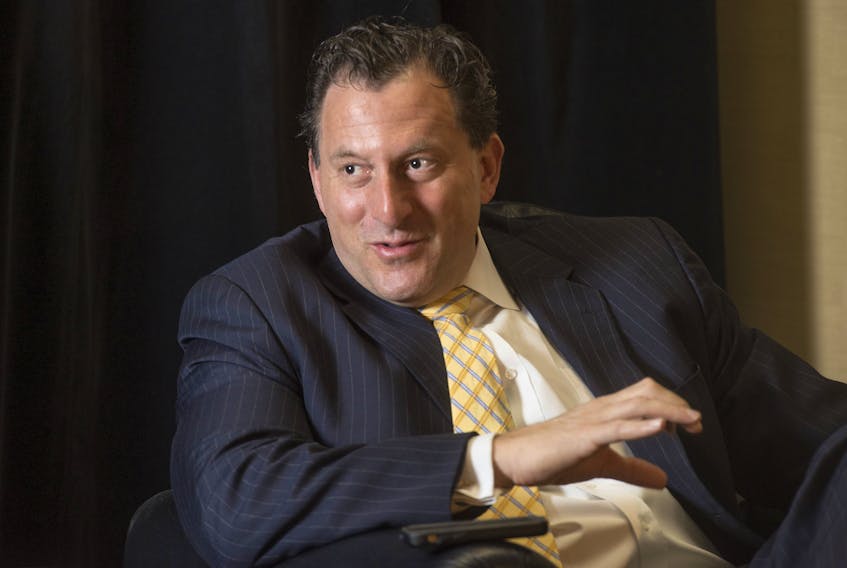The man who will determine whether or not you have to eat dog food in old age is tall and sturdy. But the pressure of running one of the world’s largest retirement pension funds seems to sit lightly upon Geoffrey Rubin’s broad shoulders.
The chief strategist for the CPP Investment Board — the largely unknown folks who manage the surplus beyond what the Canada Pension Plan needs to meet its current obligations —worked out, then dined at a Korean restaurant the night before the board’s biannual meet-the-public session in Halifax.
“I usually sleep well,” he told me Wednesday, just before the public began arriving to ask questions about how the fund is doing and whether it will be around when their kids need it.
On that last point Rubin had this to say: “The CPP is going to be there for today’s and tomorrow’s generations of retirees.”
These are unsettling days for any investment strategist, but particularly for one who needs to generate returns of 3.9 per cent annually after inflation if our national pension plan is to remain sustainable.
“Uncertain times for an uncertain length of time,” is how Rubin characterizes today’s global investment environment.
Fortunately, he and the board’s 1,600 employees, both in and outside of Canada, have had one objective and one objective only since the board was struck 20 years ago to ensure the CPP remains financially sustainable: to get the highest investment returns, period, without jeopardizing the fund’s ability to be around when we all retire.
So far so good.
In the past 20 years, the fund he quarterbacks has grown from just $60 billion to today’s $370 billion.
Rubin says about half of that increase came from the contributions of Canadians, with the other 50 per cent attributable to accumulated investment returns, in other words picking the right stocks, bonds and real estate investments.
That works out to an eight per cent annualized rate of return over the past decade, and a whopping 11.8 per cent gain last year alone.
“We understand and appreciate that those (returns) are a product of market performance and certainly can’t happen every year,” he says of the rollicking investment conditions the fund has enjoyed .
Nevertheless, with the fund’s track record and CPP contributions by both employer and employee set to increase in the years ahead, actuaries expect the retirement fund, already among the world’s 10 largest, to top $1 trillion within the next 15 years.
A fund has to search far and wide for a home for that kind of money. Particularly when its strategy is to invest for the long term in the best possible vehicles it can find, rather than to buy and sell in search of short-term profits.
That’s why Rubin’s fund — which, at last glance was more than 57 per cent invested in equities, 21 per cent in real estate and infrastructure and more than 18 per cent in fixed-income instruments — has positions in more than 4,000 companies world-wide
“The only free lunch — the only thing sure of delivering a higher level of returns in the long run — for an investor,” he says, “is being well diversified.”
Diversification, furthermore, is even more of a necessity for a fund charged with delivering growth, without sacrificing safety, at a time of such global uncertainty.
So the CPP’s fund spreads its investments, and therefore its risks, into countries all over the world. The $135 billion that it has sunk into the United States is “being closely monitored,” Rubin says.
At the same time, the fund “has every intention” of increasing its holdings in emerging markets like China, India, Brazil and other countries in their vicinity.
Because of the breadth and size of its portfolio, the fund has investments in virtually every industrial area. (One area on which it is keeping a “close eye” is the disruptive technology sector.)
That’s true of the $54 billion it has currently invested coast to coast in Canada, $3.6 billion of which has been directed to equity, fixed income and real estate investments in the four Atlantic provinces.
In Nova Scotia, the recipient of $1.5 billion of CPP capital, the fund has stakes in such well-known companies as Empire Co., Killam Apartment Real Estate Investment Trust and Emera Inc. In Newfoundland and Labrador, its $693 million in investments include a sizeable chunk of Fortis Inc.
All big names down East which, when the time comes, will help keep retired Canadians fed and housed.









